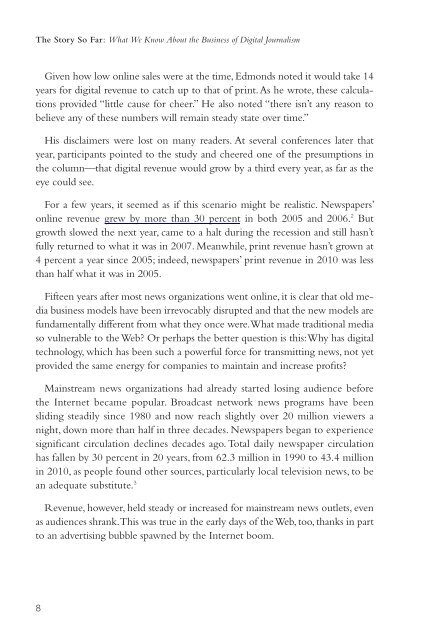What We Know About the Business of Digital Journalism
What We Know About the Business of Digital Journalism
What We Know About the Business of Digital Journalism
You also want an ePaper? Increase the reach of your titles
YUMPU automatically turns print PDFs into web optimized ePapers that Google loves.
The Story So Far: <strong>What</strong> <strong>We</strong> <strong>Know</strong> <strong>About</strong> <strong>the</strong> <strong>Business</strong> <strong>of</strong> <strong>Digital</strong> <strong>Journalism</strong>Given how low online sales were at <strong>the</strong> time, Edmonds noted it would take 14years for digital revenue to catch up to that <strong>of</strong> print. As he wrote, <strong>the</strong>se calculationsprovided “little cause for cheer.” He also noted “<strong>the</strong>re isn’t any reason tobelieve any <strong>of</strong> <strong>the</strong>se numbers will remain steady state over time.”His disclaimers were lost on many readers. At several conferences later thatyear, participants pointed to <strong>the</strong> study and cheered one <strong>of</strong> <strong>the</strong> presumptions in<strong>the</strong> column—that digital revenue would grow by a third every year, as far as <strong>the</strong>eye could see.For a few years, it seemed as if this scenario might be realistic. Newspapers’online revenue grew by more than 30 percent in both 2005 and 2006. 2 Butgrowth slowed <strong>the</strong> next year, came to a halt during <strong>the</strong> recession and still hasn’tfully returned to what it was in 2007. Meanwhile, print revenue hasn’t grown at4 percent a year since 2005; indeed, newspapers’ print revenue in 2010 was lessthan half what it was in 2005.Fifteen years after most news organizations went online, it is clear that old mediabusiness models have been irrevocably disrupted and that <strong>the</strong> new models arefundamentally different from what <strong>the</strong>y once were. <strong>What</strong> made traditional mediaso vulnerable to <strong>the</strong> <strong>We</strong>b? Or perhaps <strong>the</strong> better question is this: Why has digitaltechnology, which has been such a powerful force for transmitting news, not yetprovided <strong>the</strong> same energy for companies to maintain and increase pr<strong>of</strong>its?Mainstream news organizations had already started losing audience before<strong>the</strong> Internet became popular. Broadcast network news programs have beensliding steadily since 1980 and now reach slightly over 20 million viewers anight, down more than half in three decades. Newspapers began to experiencesignificant circulation declines decades ago. Total daily newspaper circulationhas fallen by 30 percent in 20 years, from 62.3 million in 1990 to 43.4 millionin 2010, as people found o<strong>the</strong>r sources, particularly local television news, to bean adequate substitute. 3Revenue, however, held steady or increased for mainstream news outlets, evenas audiences shrank. This was true in <strong>the</strong> early days <strong>of</strong> <strong>the</strong> <strong>We</strong>b, too, thanks in partto an advertising bubble spawned by <strong>the</strong> Internet boom.8
















